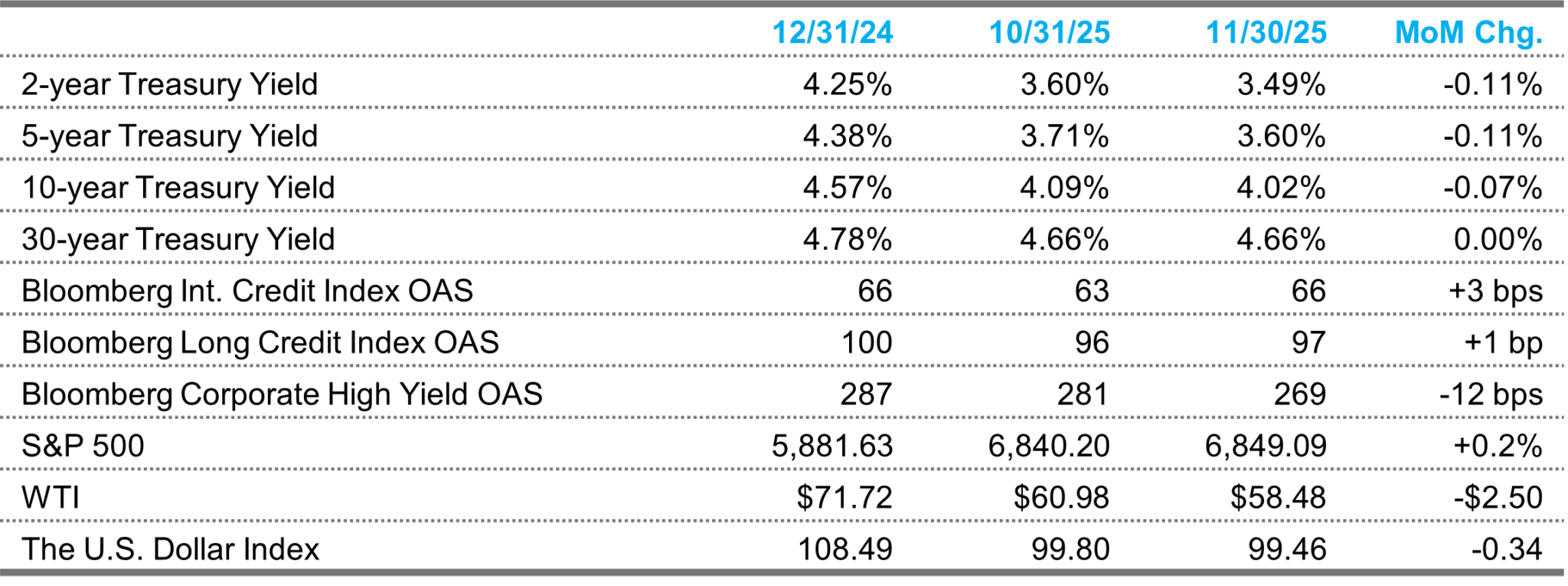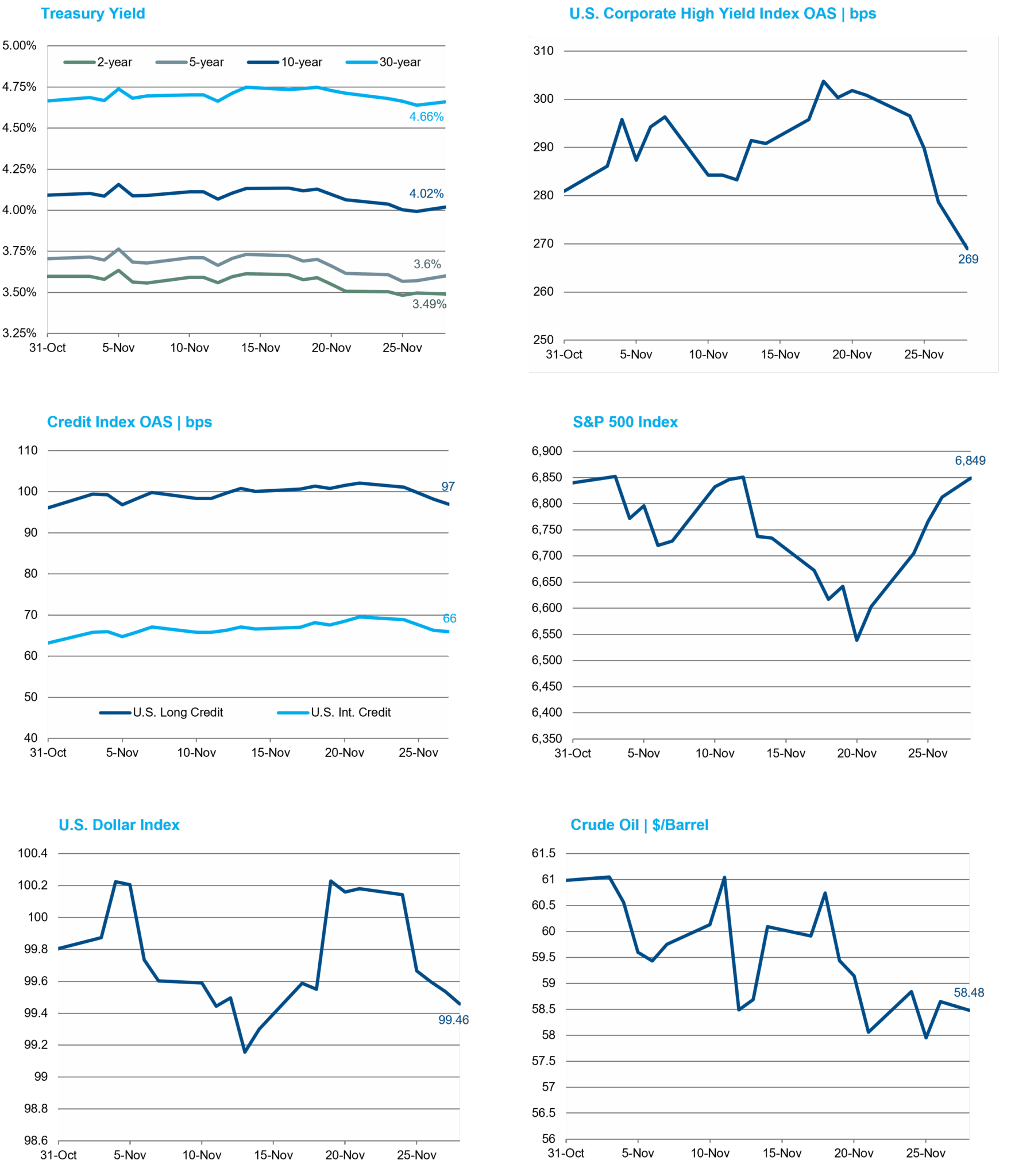Economic and Market Overview
November 2025
Equity performance was mixed, credit spreads widened and the yield curve steepened over a month that saw the government reopen and the BLS release the September Employment Situation Report 48 days later than originally scheduled.
Markets

The S&P 500 recovered from a mid-month nosedive that had the index down 4.3% MTD at one point, to finish roughly unchanged for November. A few tumbling megacaps weighed on the benchmark, however, and small caps managed to outperform as the Russell 2000 returned 1.0%. In Treasuries, the curve steepened as the front end rallied while the 30y yield finished unchanged. Credit spreads tracked equities, widening early and tightening late, as supply remained elevated. J.P. Morgan reported $137 billion in total issuance, which was 34% over the average of the prior four Novembers, though down from October’s $158 billion deluge. High yield issuance, on the other hand, increased $6 billion MoM in November to just under $25 billion. Oil was rangebound throughout the month, but WTI ultimately had its fourth straight down month. The dollar followed its second-best month of the year with its eighth monthly decline of the past eleven.
Economic Data
As the government shutdown came to an end, government agencies worked to release delayed data and announced which figures would need to take a month off. Nonfarm payrolls rose at a 119k pace in September, topping consensus by 67k, as numbers collected prior to the shutdown were finally made available on November 20. The August release was revised down to -4k, however, meaning half of the most recent four months of published data have been in the red. With retail sales a touch cooler than expectations in September, the Conference Board and University of Michigan both pointed to deteriorating consumer sentiment in November. The New York Fed’s Empire Manufacturing Index and the Philadelphia Fed’s Survey of Business Optimism gave contradictory signals once again as the former trounced consensus while the latter missed. S&P Global’s Preliminary U.S. Manufacturing PMI came up just short of expectations but fell MoM in November while its Services PMI surprised forecasts with an increase from October. The advance release of Q3 GDP will not be published, but economists expect the second release to indicate growth at around a 3.0% pace.
Inflation
The Bureau of Labor Statistics announced that October CPI will not be released, something that has never happened in the 100+ year history of the data series. This lapse will require the TIPS market to resort to a fallback provision in the Treasury’s Uniform Offering Circular which stipulates that the Treasury Department will “announce an index number based on the last available twelve-month change in the CPI.” September PCE inflation will be released on December 5, but the October release will also be skipped. Inflation expectations fell across the curve, with the 2y point leading the way, down 16 bps to 2.44%. The 30y forward rate came in a more modest 5 bps to 2.19%.
Federal Reserve
The FOMC did not meet in November. The odds of a third rate cut in December fell from 70% to 20% after the BLS delayed the release of the November payrolls report, but then swung back to 80% by the end of the month as the September payrolls report showed another increase in the unemployment rate. Communications from policymakers continued to reflect deep divisions between the hawks and doves. Despite all of the volatility in December pricing, the debate was mostly about whether to delay the cut by one month to January, which would be relatively inconsequential from a macroeconomic perspective. Secretary Bessent said he was finished interviewing candidates to succeed Chairman Powell when his term ends in late May and suggested the president may announce his nominee in December.

Sources: Bloomberg Index Services Ltd., Bloomberg.
This overview is for informational purposes only. The information has been obtained from sources considered to be reliable, but the accuracy and completeness are not guaranteed. There is no assurance that any economic trends mentioned will continue or that any forecasts will occur. Economic data are as of the dates noted.
Disclosure Information
By accepting this material, you acknowledge, understand and accept the following:
This material has been prepared by NISA Investment Advisors, LLC (“NISA”). This material is subject to change without notice. This document is for information and illustrative purposes only. It is not, and should not be regarded as “investment advice” or as a “recommendation” regarding a course of action, including without limitation as those terms are used in any applicable law or regulation. This information is provided with the understanding that with respect to the material provided herein (i) NISA is not acting in a fiduciary or advisory capacity under any contract with you, or any applicable law or regulation, (ii) that you will make your own independent decision with respect to any course of action in connection herewith, as to whether such course of action is appropriate or proper based on your own judgment and your specific circumstances and objectives, (iii) that you are capable of understanding and assessing the merits of a course of action and evaluating investment risks independently, and (iv) to the extent you are acting with respect to an ERISA plan, you are deemed to represent to NISA that you qualify and shall be treated as an independent fiduciary for purposes of applicable regulation. NISA does not purport to and does not, in any fashion, provide tax, accounting, actuarial, recordkeeping, legal, broker/dealer or any related services. You should consult your advisors with respect to these areas and the material presented herein. You may not rely on the material contained herein. NISA shall not have any liability for any damages of any kind whatsoever relating to this material. No part of this document may be reproduced in any manner, in whole or in part, without the written permission of NISA except for your internal use. This material is being provided to you at no cost and any fees paid by you to NISA are solely for the provision of investment management services pursuant to a written agreement. All of the foregoing statements apply regardless of (i) whether you now currently or may in the future become a client of NISA and (ii) the terms contained in any applicable investment management agreement or similar contract between you and NISA.

